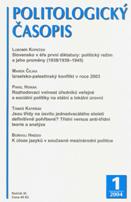Slovensko v éře první diktatury: politický režim a jeho proměny (1938/1939–1945)
Slovakia in the Era of the First Dictatorship: Political Regime and its Development (1938/1939–1945)
Author(s): Lubomír KopečekSubject(s): Politics / Political Sciences
Published by: Masarykova univerzita nakladatelství
Keywords: Slovak state; totalitarian and authoritarian regimes; Hlinka’s Slovak People’s Party
Summary/Abstract: This article applies classical typologies of totalitarian and authoritarian regimes by Zbigniew Brzezinski, Carl Friedrich and Juan Linz to the case of the first Slovak Republic (Slovak State). Its political regime between 1938/1939 and summer 1940 can be classified as organic statism. “Organic structures” (corporativist structures) and the antiliberal and anticapitalist rhetoric of the Catholic Church in encyclicals like the Rerum Novarum were typical of this type of authoritarian regime. Nevertheless, the Nazi pressure led to the transition of the regime to the “defective” (or “arrested”) totalitarian regime, which is, according to Linz’s typology, in the “grey” zone between totalitarian and authoritarian regimes. The defeats of the German army and changes inside Slovak’s camp resulted in the erosion of the regime base at the end of 1942 and brought about yet another regime change. The end of the stage of “unclear” authoritarian regime was marked by the armed insurrection in August 1944. The totalitarian episode, in which the main role was played by the German occupation forces, characterized the last months of war
Journal: Politologický časopis - Czech Journal of Political Science
- Issue Year: XI/2004
- Issue No: 1
- Page Range: 4-27
- Page Count: 23
- Language: Czech

